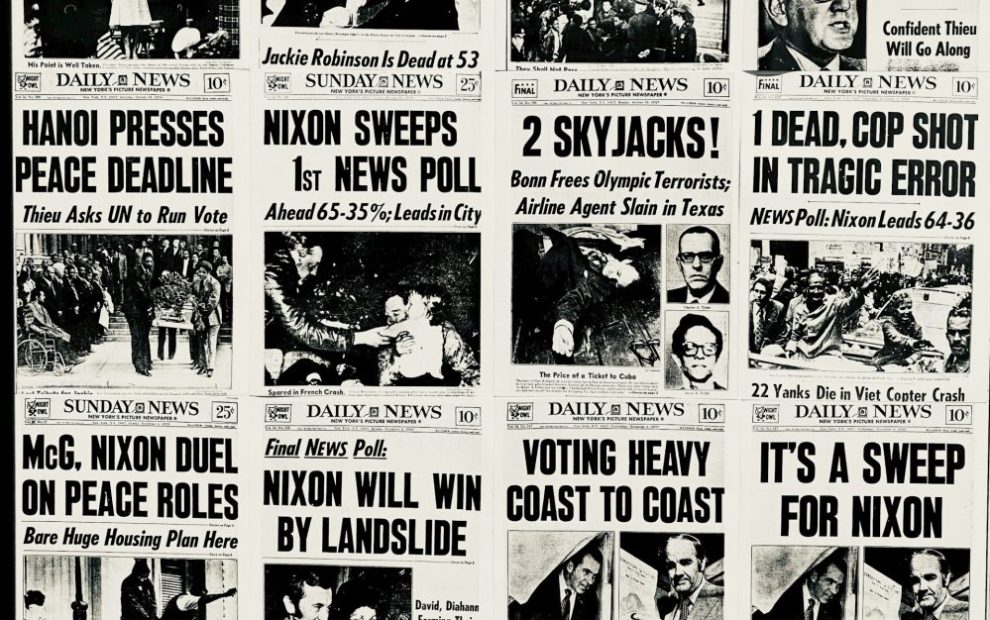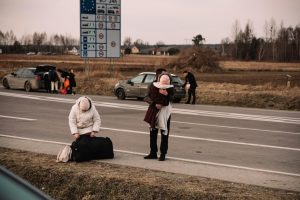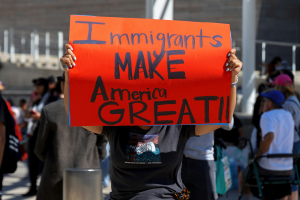A voting myth goes like this: In a presidential election, Evangelicals go right. Jews and Black Protestants veer left. Catholics take the middle, the swing vote that decides who will be the most powerful person in the world for the next four years. In many ways, that’s a reassuring thought, that Catholics take the wise middle ground, quietly asserting their role as the arbiters of our national fate.
As with most myths, it contains an element of truth, provided you count as Catholic everyone who was baptized into the church and is an American voter. That view is consistent with canon law, which determines that baptism is what makes a Catholic, not church attendance or parish registration. Catholics defined in this most generous sense, then, remain swing votes in national elections; where they put their votes tends to determine the winner.
If you are a churchgoing American Catholic of European descent, odds are you are firmly in the Republican camp and have been so for decades. According to Pew research, 59 percent of churchgoing Catholics opted in 2020 for Republican presidential nominee Donald Trump. Just looking at that slice of churchgoing Catholics, it was a Republican landslide.
Here’s a history lesson, though: It wasn’t always so. Catholics were part of the Democratic coalition for generations, ever since the post-Civil War era when big-city political machines prospered by exchanging the Catholic vote for patronage and favors, allowing immigrants to move up the economic ladder. Immigration after the Civil War brought more and more Catholics into the political mainstream.
At the time, the Democrats, who were seen as the party that sympathized with the Confederacy in the Civil War, needed the infusion. In response, they forged a coalition of labor unions, Catholic immigrants, and the remnants of the defeated South. “Rum, Romanism, and Rebellion” was the tag given Democrats in late nineteenth-century elections, a reference to many Catholics’ anti-Prohibition stance, their support of the pope, and the Southern states’ reluctance to accept Reconstruction.
Catholics’ allegiance to the Democrats—and the backlash of vicious anti-Catholicism—peaked in 1928 when Al Smith was nominated for president. The Catholic New York governor became the target of vitriolic attacks that claimed his presidency would put the United States under the Vatican’s control. He lost in a landslide.
Despite that debacle, the Democrats’ alliance with Catholic voters continued. Father John Ryan, a Catholic social theorist of the early twentieth century, foreshadowed much of Franklin Roosevelt’s progressive domestic programs. The U.S. bishops’ conference helped forge the policy that Roosevelt later dubbed the “New Deal.”
Not that all Catholics were Democrats, but their largely urban presence bolstered turnout for Democratic presidential candidates and other officeholders. By 1960, when John Kennedy was the Democratic nominee, Catholics proved they had arrived in the American mainstream. JFK’s presidency would not have happened without the majority of the Catholic vote in what turned out to be a razor-thin election. In the decade that followed, priests and nuns were at the forefront of the civil rights and peace movements.
But 1972 changed the Democratic party.
As a presidential election year, 1972 was a kind of orphan, a freak of circumstances, and at the same time, it was a watershed moment. The contest was between Democrat George McGovern, a soft-spoken Senator from South Dakota, and incumbent Republican Richard Nixon. The political atmosphere was rife with polarization, much like today’s. It was an era of political violence.
The widely unpopular Vietnam War seemed to be winding down, at least when it came to direct American involvement, and Nixon capitalized on a backlash to the rebellions and discord of the era, appealing to churchgoing Catholics. The Republicans successfully tied the Democrats to “abortion, acid, and amnesty,” a three-pronged cultural assault that focused on buttressing Catholic patriotism and moral values on the sanctity of life, opposition to illegal drugs, and intolerance for Vietnam War draft evaders.
Kevin Phillips, who died in 2023 at the age of 82, was in 1972 a political advisor and author of The Emerging Republican Majority; he counseled Nixon to reach out to disaffected white southern Democrats who opposed the civil rights revolution, an approach that came to be called the “Southern Strategy.” His insight into politics, he would later say, was based on understanding who hates whom.
But perhaps even more consequential than the Southern Strategy was Phillips’ advice to take apart the old Democratic allegiance of ethnic White Catholics in the Northeast and Midwest, something Nixon successfully accomplished. Nixon’s close election in 1968 spoke of “a new era in American politics,” wrote Phillips. By 1972, Nixon had cemented that edge and won the popular vote by a 22-point margin, numbers not seen before or since. After the election, Americans chuckled at the “Don’t Blame Me I’m from Massachusetts” bumper stickers, alluding to the only state McGovern won that year.
Nixon was able to reshape the electorate, with wide support from Catholic Democrats who once voted for tickets led by Roosevelt, Truman, Kennedy, Johnson, and Humphrey, in part by adeptly exploiting White Catholic anxiety about racial issues. Then, just months after the 1972 election, the U.S. Supreme Court legalized abortion nationwide in its Roe decision. After decades of church teaching against abortion, Catholics aligned with Republicans who largely lined up on the anti-Roe side favored by church leaders.
One Catholic voter in 1972 was my father, who announced at dinner one night that he was going to vote Republican. He had been the swing vote in the family, as my mother almost always went Republican. My father, who encouraged political discussion around the table with his children, tended to vote Democratic in presidential elections.
A Catholic college graduate who attended a Jesuit university on the G.I. Bill, a regular churchgoer, my father, Vic Feuerherd, was well aware of Catholic social teaching. When my three-year-old brother died of leukemia after a long hospitalization, my father longed for some kind of socialized medicine for financially strapped families confronting catastrophic illness. He wrote an article for the Jesuit-run America Magazine, calling for business leaders to be forthright in supporting civil rights. (When we went to the public library together, he would proudly have us look up his article.)
After 1972, he would never again vote for a Democrat for president. His last ballot, before he died in 2004, was for George W. Bush.
My father’s story is familiar to Ryan Burge, a political scientist at Eastern Illinois University who studies the impact of faith on politics and culture, as well as the wider picture of what it means to be a religious American in the twenty-first century. The data is clear, he says: “The more Catholics go to Mass is the more they go for Republicans.”
Still, religious faith often plays a secondary role in how people vote, he says. Other considerations may trump political affinity. Burge notes, for example, that although President Joe Biden is the most churchgoing president in history, a regular congregant at Mass, and the second Catholic president of the United States, none of that helped him garner many churchgoing Catholics’ votes in the 2020 election.
Burge notes that although most Catholic churchgoers rarely hear about partisan politics from the pulpit, they have tended, like the rest of society, to sort themselves into political camps. While Catholics used to be wedded to territorial parishes, now parish shoppers seek out liturgies that suit their ideological preference. Polarization is baked into the American Catholic mix, just as it is in the rest of the United States.
Across all denominations, Burge says, churchgoing is a practice skewed toward a more conservative demographic. Churchgoers in the United States are increasingly older, more affluent, and established in their communities, factors that correlate with a friendlier view of conservative politics, according to Burge. Biden’s coalition in 2020 included racial minorities, younger single people, single mothers, and others who don’t always fit into the demographic likely to attend weekly church services. Some 40 percent of millennials who identify as Democrats say they never attend church, Burge reports.
“The people who are the most likely to attend services this weekend are those with college degrees making between 60 and 100K. In other words, middle-class professionals,” says Burge. By contrast, he adds, about 45 percent of the 2020 vote for Biden came from people who have given up on organized religion entirely.
White Catholics who attend Mass more than once a month voted for Trump in overwhelming numbers—but that is not true for Black and Latino Catholics.
The Black Catholic vote remains overwhelmingly Democrat. Blacks comprise almost 14 percent of the general population but only 4 percent of Catholics. In 2016, 86 percent of Black Catholics voted for Hillary Clinton; three quarters of Black Catholics, according to Burge, identify as Democrats. Those numbers are not much different from Black Protestants’, although African American Catholics are slightly more inclined to vote Republican than Black Protestants are.
While Donald Trump appealed to more Latinos in 2020—his wide victory in Florida indicated his appeal among Cuban Americans and Venezuelan immigrant voters—Democrats still hold a wide margin among Latino Catholics, both churchgoers and non-churchgoers.
Is it time to reevaluate Catholics’ devotion to the Republican Party? Jason Miller, for one, thinks it is. Now that the U.S. Supreme Court has overturned Roe, allowing states to make their own decisions on abortion, Miller says it’s time for Catholic leaders to change their tune when it comes to signaling their support for Republicans. “There is no reason to vote for Trump now. You won the battle. What’s the excuse now?” he asks.
Still, the U.S. bishops, at their November 2023 meeting where they approved their document on political responsibility, noted their belief that abortion remains a “pre-eminent” priority among the roster of life issues with which Catholics should be concerned.
I sometimes teach at a large urban Catholic university, filled with students from all kinds of backgrounds, from pious Catholic families to atheists and agnostics. Whenever the subject of the church’s role in the public sphere comes up, students point to abortion and LGBTQ issues. These, in their eyes, are the only matters Catholics appear to care about.
If we see American Catholics as the conservative party at prayer, we leave out many nonwhite Catholics—and we are at odds with most of U.S. history. “Everyone, everyone, everyone!” Pope Francis famously called out at World Youth Day last year. Catholics who yearn for a church that embraces new partisan stripes might echo that exhortation.
Image: Unsplash/Arno Senoner














Add comment